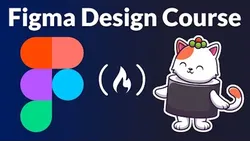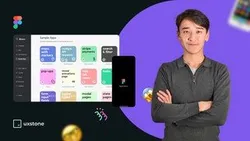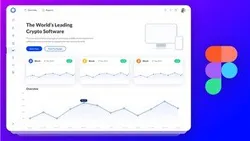
Figma Course - Web Design Tutorial for Beginners 
This course provides an introduction to Figma, a powerful web design tool, for beginners. Learn the basics of creating and editing websites with this comprehensive tutorial. ▼
ADVERTISEMENT
Course Feature
![]() Cost:
Cost:
Free
![]() Provider:
Provider:
freeCodeCamp
![]() Certificate:
Certificate:
Paid Certification
![]() Language:
Language:
English
![]() Start Date:
Start Date:
On-Demand
Course Overview
❗The content presented here is sourced directly from freeCodeCamp platform. For comprehensive course details, including enrollment information, simply click on the 'Go to class' link on our website.
Updated in [April 29th, 2023]
Welcome to the Figma Course - Web Design Tutorial for Beginners! This course is designed to help you learn how to use Figma to design websites.
Course Overview: This course will provide you with an introduction to Figma, the basics of web design, and how to use Figma to create a website. You will learn how to create a website from scratch, how to use Figma’s tools to customize your website, and how to use Figma to create a website that looks professional.
Possible Development Directions: After completing this course, you will be able to create a website from scratch, customize it with Figma’s tools, and create a website that looks professional. You will also be able to use Figma to create a website that is optimized for mobile devices, and you will be able to use Figma to create a website that is optimized for search engine optimization.
Related Learning Suggestions: After completing this course, you may want to explore other web design tools such as Adobe Photoshop, Adobe Illustrator, and Sketch. You may also want to explore other web design topics such as HTML, CSS, and JavaScript. Additionally, you may want to explore other web design topics such as user experience design, web accessibility, and web security.
[Applications]
After completing this course, students should be able to apply their knowledge of Figma to create professional-looking websites. They should be able to use the tools and features of Figma to create layouts, design elements, and add interactivity to their websites. Additionally, they should be able to use Figma to collaborate with other designers and developers to create a website that meets the needs of their clients.
[Career Paths]
1. Web Designer: Web designers use Figma to create visually appealing websites that are optimized for user experience. They are responsible for creating the overall look and feel of a website, including the layout, color scheme, and typography. Web designers must stay up-to-date on the latest trends in web design and be able to create websites that are both aesthetically pleasing and functional.
2. UX/UI Designer: UX/UI designers use Figma to create user-friendly interfaces for websites and applications. They are responsible for creating the user experience and interface design, including the navigation, layout, and visual elements. UX/UI designers must have a strong understanding of user behavior and be able to create interfaces that are both intuitive and visually appealing.
3. Front-End Developer: Front-end developers use Figma to create the code that powers websites and applications. They are responsible for writing the code that makes websites and applications functional, including HTML, CSS, and JavaScript. Front-end developers must have a strong understanding of web technologies and be able to create code that is both efficient and secure.
4. Motion Designer: Motion designers use Figma to create animations and interactive elements for websites and applications. They are responsible for creating the visual effects and transitions that make websites and applications more engaging and interactive. Motion designers must have a strong understanding of animation principles and be able to create animations that are both visually appealing and functional.
[Education Paths]
1. Bachelor of Science in Computer Science: This degree path provides students with a comprehensive understanding of computer science principles and technologies. Students learn how to design, develop, and maintain software applications, as well as how to use programming languages to create websites. This degree path is becoming increasingly popular as the demand for web developers continues to grow.
2. Bachelor of Science in Web Design and Development: This degree path focuses on the design and development of websites. Students learn how to create user-friendly websites, as well as how to use HTML, CSS, and JavaScript to create interactive webpages. This degree path is becoming increasingly popular as the demand for web designers and developers continues to grow.
3. Master of Science in Web Design and Development: This degree path focuses on advanced web design and development techniques. Students learn how to create complex websites, as well as how to use advanced technologies such as AJAX and XML. This degree path is becoming increasingly popular as the demand for web designers and developers with advanced skills continues to grow.
4. Master of Science in Human-Computer Interaction: This degree path focuses on the design of user interfaces for websites and other digital products. Students learn how to create user-friendly websites, as well as how to use user research and usability testing to create effective user experiences. This degree path is becoming increasingly popular as the demand for user experience designers continues to grow.
Course Provider

Provider freeCodeCamp's Stats at AZClass
Discussion and Reviews
0.0 (Based on 0 reviews)
Explore Similar Online Courses

Product Marketing Foundations

Inside IELTS: Preparing for the Test With the Experts

Python for Informatics: Exploring Information

Social Network Analysis

Introduction to Systematic Review and Meta-Analysis

The Analytics Edge

DCO042 - Python For Informatics

Causal Diagrams: Draw Your Assumptions Before Your Conclusions

Whole genome sequencing of bacterial genomes - tools and applications

From idea to MVP without coding Intro to Figma & Bravo

Learn How to Design a Website in Figma

Redesigning Amazon App Using Figma
 Related Categories
Related Categories
 Popular Providers
Popular Providers
Quiz
 Submitted Sucessfully
Submitted Sucessfully
1. What is Figma?
2. What is the purpose of Figma?
3. What type of files can be created with Figma?


Start your review of Figma Course - Web Design Tutorial for Beginners